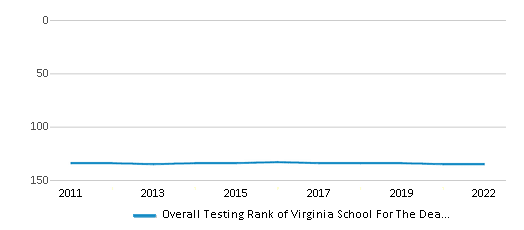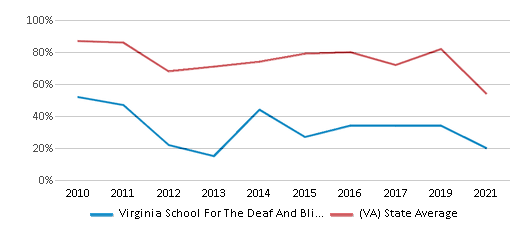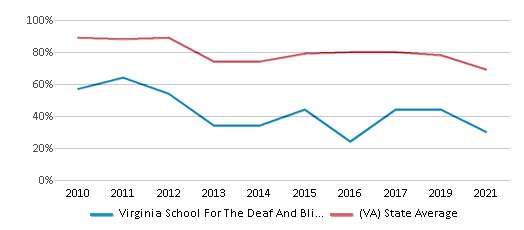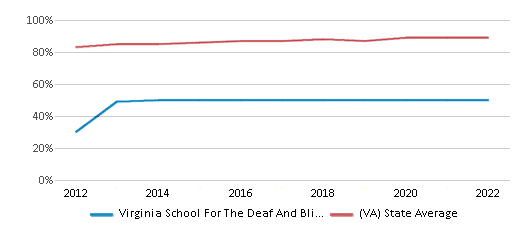Top Rankings
Virginia School For The Deaf And Blind-Staunton School District ranks among the top 20% of public school district in Virginia for:
Category
Attribute
Diversity
Most diverse schools (Top 1%)
Student Attention
Lowest student:teacher ratio (Top 1%)
For the 2025 school year, there is 1 public high school serving 34 students in Virginia School For The Deaf And Blind-Staunton School District.
Public High Schools in Virginia School For The Deaf And Blind-Staunton School District have a diversity score of 0.60, which is less than the Virginia public high school average of 0.71.
Public High School in Virginia School For The Deaf And Blind-Staunton School District have a Graduation Rate of 50%, which is less than the Virginia average of 89%.
The school with highest graduation rate is Virginia School For The Deaf And Blind High School, with <50% graduation rate. Read more about public school graduation rate statistics in Virginia or national school graduation rate statistics.
Minority enrollment is 41% of the student body (majority Black), which is less than the Virginia public high school average of 55% (majority Black and Hispanic).
Overview
This School District
This State (VA)
# Schools
3 Schools
354 Schools
# Students
57 Students
411,759 Students
# Teachers
24 Teachers
29,555 Teachers
Student : Teacher Ratio
2:1
2:1
District Rank
Virginia School For The Deaf And Blind-Staunton School District, which is ranked within the bottom 50% of all 135 school districts in Virginia (based off of combined math and reading proficiency testing data) for the 2020-2021 school year.
The school district's graduation rate of 50% has stayed relatively flat over five school years.
Overall District Rank
#135 out of 135 school districts
(Bottom 50%)
(Bottom 50%)

Math Test Scores (% Proficient)
(20-21)≤20%
54%

Reading/Language Arts Test Scores (% Proficient)
(20-21)21-39%
69%

Science Test Scores (% Proficient)
(20-21)<50%
59%
Graduation Rate
<50%
89%

Students by Ethnicity:
Diversity Score
0.67
0.71
# American Indian Students
n/a
1,051 Students
% American Indian Students
n/a
n/a
# Asian Students
7 Students
32,382 Students
% Asian Students
12%
8%
# Hispanic Students
7 Students
79,163 Students
% Hispanic Students
12%
19%
# Black Students
10 Students
88,695 Students
% Black Students
18%
22%
# White Students
30 Students
184,825 Students
% White Students
53%
45%
# Hawaiian Students
n/a
701 Students
% Hawaiian Students
n/a
n/a
# Two or more races Students
3 Students
24,942 Students
% of Two or more races Students
5%
6%
Students by Grade:
# Students in PK Grade:
2
190
# Students in K Grade:
-
377
# Students in 1st Grade:
-
163
# Students in 2nd Grade:
-
184
# Students in 3rd Grade:
-
464
# Students in 4th Grade:
1
333
# Students in 5th Grade:
4
400
# Students in 6th Grade:
7
1,059
# Students in 7th Grade:
5
3,129
# Students in 8th Grade:
4
5,026
# Students in 9th Grade:
3
105,013
# Students in 10th Grade:
12
103,738
# Students in 11th Grade:
5
97,088
# Students in 12th Grade:
14
94,595
# Ungraded Students:
-
-
Best Virginia School For The Deaf And Blind-Staunton School District Public High Schools (2025)
School
(Math and Reading Proficiency)
(Math and Reading Proficiency)
Location
Grades
Students
Rank: #11.
Virginia School For The Deaf And Blind High School
Special Education School
(Math: <50% | Reading: <50% )
Rank:
Rank:
1/
Bottom 50%10
104 Vsdb Dr.
Staunton, VA 24402
(540) 332-9014
Staunton, VA 24402
(540) 332-9014
Grades: 9-12
| 34 students
Recent Articles

Year-Round Or Traditional Schedule?
Which is more appropriate for your child? A year-round attendance schedule or traditional schedule? We look at the pros and cons.

Why You Should Encourage Your Child to Join a Sports Team
Participating in team sports has a great many benefits for children, there is no doubt. In this article you will learn what those benefits are.

White Students are Now the Minority in U.S. Public Schools
Increasing birth rates among immigrant families from Asia and Central and South America, combined with lower birth rates among white families, means that for the first time in history, public school students in the United States are majority-minority. This shift in demographics poses difficulties for schools as they work to accommodate children of varying language abilities and socio-economic backgrounds.





